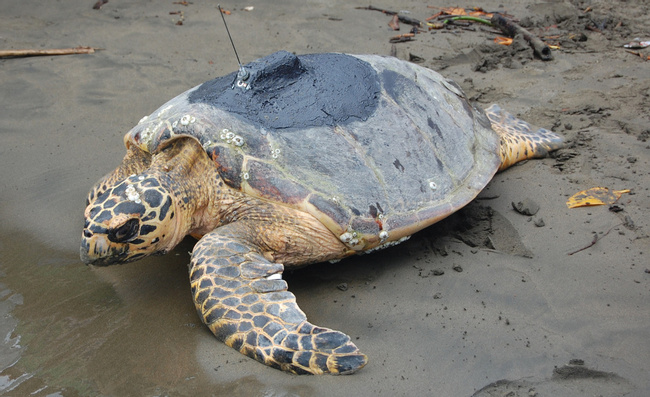Hawksbill Sea Turtle
Hawksbill Sea Turtle (Eretmochelys imbricata) Spanish Name: Tortuga carey

More about Hawksbill Sea Turtle
Habitat
The hawksbill prefers shallow coastal waters and is frequently found around underwater rocks and coral reefs. Sometimes they are seen in estuaries.
Range
This turtle lives in the warm tropical and subtropical waters of the Pacific, Atlantic, and Indian oceans as well as the Caribbean Sea.
Physical Description
The hawksbill is distinct among the sea turtles. It has a beaklike mouth that is curved and sharp, helping the turtle protect itself and eat. This is the only turtle with overlapping scutes (plates) on its shell. The shell is heart-shaped or shield-shaped; the edge becomes serrated toward the rear of the body. The hawksbill also has two pairs of large scales on its head between the eyes. Finally, and importantly, this turtle has an iridescent brown and cream pattern on its back popularly known as "tortoiseshell."?
Both sexes of this species have brown to reddish-brown scales on their skin that are bordered with yellow. The plastron, or underside, is yellow. The female's plastron is flat, but the male has a plastron that curves inward. This helps the male hold onto the female better when they mate, because her shell curves out. The male also has a long tail that can help him hold on.
Biology and Natural History
Dangerous as it is delicate, the hawksbill can and does defend itself with its large, hooked upper jaw. This is one of the most aggressive sea turtles.
Males and females meet in the shallow waters offshore of nesting beaches between April and November, with the highest activity in June or July. But these turtles mate when the female is returning to sea after laying her eggs, so their coupling is for a future season. Unlike the green turtle and olive ridley, the hawksbill is an individual nester. A female comes to nest once every three years, and she lays multiple clutches of eggs. At night, she crawls ashore, digs a chamber in the sand with her hind flippers, and releases between 50 and 200 eggs. She then pushes sand back over the eggs and heads back to the surf. Her eggs will hatch after 8 or 9 weeks, and the young turtles will begin racing to the water.
This turtle's diet makes it poisonous to humans (see below), but the hawksbill has still been overhunted for a long time. The hawksbill's shell, uniquely patterned and considered fashionable in some places, made the turtle a target for hunters. The shells were used for combs, jewelry, and other trinkets at the cost of heavily endangering the irreplaceable hawksbill. Now tortoiseshell patterns are manufactured so there should not be demand for the turtle's body. Still, poachers kill these turtles for their shells, meat, and eggs.
The hawksbill is a critically endangered species. It is protected by international policies and illegal to hunt. Read about Sea Turtles: Promises and Threats to learn more about the challenges facing this animal.
Diet
As a younger turtle, the hawksbill eats both plants and prey, but as it matures it eats more meat, including fish, mollusks, and sponges. It is able to eat jellyfish, and even eats the dangerously poisonous Portuguese man-of-war. Toxins from the jellyfish and sponges that the turtle eats make it a dangerous meal for humans, even though some still sell it as food. As long as people keep buying turtle eggs, meat, or shells, the fate of these delicate creatures is at great risk.
Height/Weight
At its largest, the hawksbill can reach almost 100 cm in length.
Taxonomy
Order: Testudines
Family: Cheloniidae
Source
Leenders, Twan. A Guide to Amphibians and Reptiles of Costa Rica. Zona Tropical, S.A, Miami, FL, 2001.
-Amy Strieter, Wildlife Writer
Hawksbill Sea Turtle Sightings
Similar Profiles
We believe travel is more than ticking destinations off a list – it’s about discovering new places deeply, feeling connected wherever you go, and knowing you have a trusted team behind you every step of the way.



